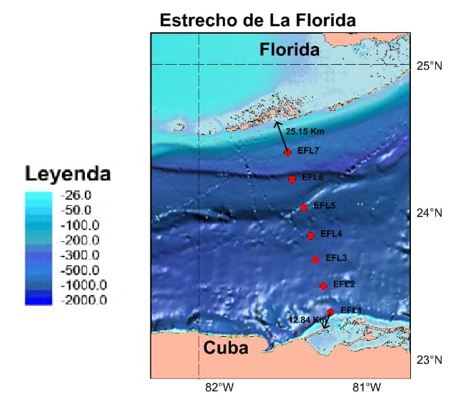Florida Current (81º W) behavior between 2012 and 2018
Main Article Content
Abstract
The behavior of marine currents in the Florida Straits was sampled by seven oceanographic moorings between 2012 and 2018. Using data from one of these moorings, the behavior of the Florida Current during said period was analyzed. The statistical parameters used in the research were: minimum, maximum, mean, standard deviation, anomalous values, and Pearson's correlation coefficient. Current roses were obtained at different depths from the filtered data with a cut frequency of 48 hr-1. The maximum magnitude values of the Florida Current reached up to 2 m/s, with a movement towards the east-northeast or east. Absolute values of the anomalies in the study period 2012 -2018 did not exceed 0.15 m/s, and those of monthly anomalies alternated their sign in a biannual or triannual period. An extremely low linear correlation was detected between annual series for all depths of the analysis, with absolute Pearson correlation values lower than 0.31. Particularly, between August-2013 and August-2014, the Florida Current showed a slight tendency to slow down; and in the period August-2015 // August-2016, a predominance in its proximity to Cuba. No evidence was found of anomalous behavior of the Florida Current with respect to its historical behavior.
Downloads
Article Details

This work is licensed under a Creative Commons Attribution-NonCommercial 4.0 International License.
Those authors who have publications with this journal accept the following terms of the License Attribution-NonCommercial 4.0 International (CC BY-NC 4.0):
You are free to:
- Share — copy and redistribute the material in any medium or format
- Adapt — remix, transform, and build upon the material
The licensor cannot revoke these freedoms as long as you follow the license terms.
Under the following terms:
- Attribution — You must give appropriate credit, provide a link to the license, and indicate if changes were made. You may do so in any reasonable manner, but not in any way that suggests the licensor endorses you or your use.
- NonCommercial — You may not use the material for commercial purposes.
- No additional restrictions — You may not apply legal terms or technological measures that legally restrict others from doing anything the license permits.
The journal is not responsible for the opinions and concepts expressed in the works, they are the sole responsibility of the authors. The Editor, with the assistance of the Editorial Committee, reserves the right to suggest or request advisable or necessary modifications. They are accepted to publish original scientific papers, research results of interest that have not been published or sent to another journal for the same purpose.
The mention of trademarks of equipment, instruments or specific materials is for identification purposes, and there is no promotional commitment in relation to them, neither by the authors nor by the publisher.
References
Androulidakis, Y., Kourafalou, V., Le Hénaff, M., Kang, H., Ntaganou, N., & Hu, C. (2020). Gulf Stream evolution through the Straits of Florida: The role of eddies and upwelling near Cuba. Ocean Dynamics, 70(8), 1005–1032. https://doi.org/10.1007/s10236-020-01381-5
Arriaza-Oliveros, L., Sánchez-Pérez, E. O., Rivero-Ordaz, L., Trincado-Ventura, J. A., Fernández, C. A., Benítez-Rodríguez, L., Carrillo-Betancourt, Y., Navarro-Padrón, J., Bolívar-Rodríguez, C., Almanza-Galván, D. O., Hernández-González, M., Pi-Martínez, Á., Viamontes-Fernández, J. L., Peña de la Cruz, N., Orduñez-Diaz, A., Ochoa, J. L., & Candela, J. (2019). Circulación marina y conectividad dinámica en las aguas oceánicas alrededor del Cuba. (Cambio climático en Cuba: impactos, mitigación y adaptación, pp. 1–154). Instituto de Ciencias del Mar (ICIMAR).
Candela, J., Ochoa, J., Sheinbaum, J., López, M., Pérez-Brunius, P., Tenreiro, M., Pallás-Sanz, E., Athié, G., & Arriaza-Oliveros, L. (2019). The flow through the Gulf of Mexico. Journal of Physical Oceanography. https://doi.org/10.1175/JPO-D-18-0189.1
Emery, W., & Thomson, R. (2004). Data Analysis Methods in Physical Oceanography: Third Edition. En Eos, Transactions American Geophysical Union (Vol. 80, p. 638). https://doi.org/10.2307/1353059
Gallegos, A., Victoria, I., Zavala, J., Fernández, M., Barberán, J., Penié, I., Fernández, A., & C., M. (1998). Condiciones oceánicas en el Canal de Yucatán, el Estrecho de la Florida (Cayo Hueso-La Habana), el Canal Viejo de Bahamas, el Paso de los Vientos, el Estrecho de Colón y el mar del Caimán, en noviembre de 1989 y abril de 1991 (Informe Final de Proyecto del ICML (UNAM, México DF) y del IDO (CITMA, La Habana), p. 46).
Gordon, R. L. (2011). Acoustic Doppler current profiler: Principles of operation, a practical primer. (Vol. 00, Número January). http://www.rdinstruments.com
Gyory, J., Rowe, E., Mariano, A. J., & Ryan, E. H. (2013). The Florida Current. Ocean Surface Currents. https://oceancurrents.rsmas.miami.edu/atlantic/florida.html
Hamilton, P., Larsen, J. C., Leaman, K. D., Lee, T. N., & Waddell, E. (2005). Transports through the Straits of Florida. Journal of Physical Oceanography, 35(3), 308–322. https://doi.org/10.1175/JPO-2688.1
Kourafalou, V., Androulidakis, Y., Le Hénaff, M., & Kang, H. S. (2017). The Dynamics of Cuba Anticyclones (CubANs) and Interaction with the Loop Current/Florida Current System. Journal of Geophysical Research: Oceans, 122(10), 7897–7923. https://doi.org/10.1002/2017JC012928
Mamaev, O. I. (1970). TS – análisis de las aguas del océano mundial. Gidrometisdat, 363.
Mitrani-Arenal, I., & Díaz-Rodríguez, O. O. (2008). Particularidades de la estructura termohalina y sus tendencias en aguas cubanas. Revista Cubana de Meteorología, 14(1), Article 1.
Rousset, C., & Beal, L. M. (2010). Observations of the Florida and Yucatan Currents from a Caribbean Cruise Ship. Journal of Physical Oceanography, 40(7), 1575–1581. https://doi.org/10.1175/2010JPO4447.1

